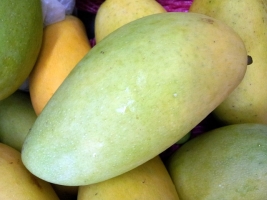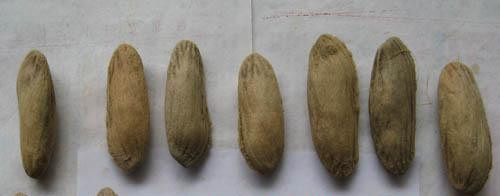 Mangifera
indica 芒
果
Máng guǒ Common
Mango
Mangifera
indica 芒
果
Máng guǒ Common
Mango
 Mangifera
indica 芒
果
Máng guǒ Common
Mango
Mangifera
indica 芒
果
Máng guǒ Common
Mango

 芒
果 核
Máng guǒ hé
Mango stone
芒
果 核
Máng guǒ hé
Mango stone
Anticarcinogenic effects of polyphenolics from mango (Mangifera indica)
varieties.
Noratto GD, Bertoldi MC, Krenek K, Talcott ST, Stringheta PC, Mertens-Talcott
SU.
Abstract
Many polyphenolics contained in mango have shown anticancer activity. The objective
of this study was to compare the anticancer properties of polyphenolic extracts
from several mango varieties (Francis, Kent, Ataulfo, Tommy Atkins, and Haden)
in cancer cell lines, including Molt-4 leukemia, A-549 lung, MDA-MB-231 breast,
LnCap prostate, and SW-480 colon cancer cells and the noncancer colon cell line
CCD-18Co. Cell lines were incubated with Ataulfo and Haden extracts, selected
on the basis of their superior antioxidant capacity compared to the other varieties,
where SW-480 and MOLT-4 were statistically equally most sensitive to both cultivars
followed by MDA-MB-231, A-549, and LnCap in order of decreasing efficacy as
determined by cell counting. The efficacy of extracts from all mango varieties
in the inhibition of cell growth was tested in SW-480 colon carcinoma cells,
where Ataulfo and Haden demonstrated superior efficacy, followed by Kent, Francis,
and Tommy Atkins. At 5 mg of GAE/L, Ataulfo inhibited the growth of colon SW-480
cancer cells by approximately 72% while the growth of noncancer colonic myofibroblast
CCD-18Co cells was not inhibited. The growth inhibition exerted by Ataulfo and
Haden polyphenolics in SW-480 was associated with an increased mRNA expression
of pro-apoptotic biomarkers and cell cycle regulators, cell cycle arrest, and
a decrease in the generation of reactive oxygen species. Overall, polyphenolics
from several mango varieties exerted anticancer effects, where compounds from
Haden and Ataulfo mango varieties possessed superior chemopreventive activity.J
Agric Food Chem. 2010 Apr 14;58(7):4104-12. doi: 10.1021/jf903161g.
ncbi.nlm.nih.gov
Anti-diabetic effect of dietary mango (Mangifera indica L.) peel in
streptozotocin-induced diabetic rats.
Gondi M, Basha SA, Bhaskar JJ, Salimath PV, Prasada Rao UJ.
Abstract
BACKGROUND:
In the present study, the composition of mango peel powder (MPP) collected from
the mango pulp industry was determined and the effect of MPP on ameliorating
diabetes and its associated complications was studied.
RESULTS:
Mango peel was rich in polyphenols, carotenoids and dietary fibre. Peel extract
contained various bioactive compounds and was found to be rich in soluble dietary
fibre. Peel extract exhibited antioxidant properties and protected against DNA
damage. Therefore, the effect of peel on ameliorating diabetes was investigated
in a rat model of diabetes. A significant increase in urine sugar, urine volume,
fasting blood glucose, total cholesterol, triglycerides and low density lipoprotein,
and decrease in high density lipoprotein were observed in the rats; however,
these parameters were ameliorated in diabetic rats fed with diet supplemented
with mango peel at 5% and 10% levels in basal diet. Treatment of diabetic rats
with MPP increased antioxidant enzyme activities and decreased lipid peroxidation
in plasma, kidney and liver compared to untreated diabetic rats. Glomerular
filtration rate and microalbuminuria levels were ameliorated in MPP treated
diabetic group.
CONCLUSIONS:
Mango peel, a by-product, can be used as an ingredient in functional and therapeutic
foods. © 2014 Society of Chemical Industry.
© 2014 Society of Chemical Industry.J Sci Food Agric. 2015 Mar 30;95(5):991-9.
doi: 10.1002/jsfa.6778. Epub 2014 Jul 10. ncbi.nlm.nih.gov